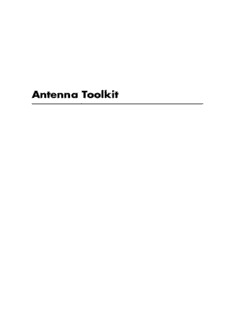
Antenna Toolkit PDF
Preview Antenna Toolkit
Antenna Toolkit Antenna Toolkit 2nd Edition Joseph J. Carr, K4IPV Newnes OXFORD AUCKLAND BOSTON JOHANNESBURG MELBOURNE NEWDELHI Newnes AnimprintofButterworth-Heinemann LinacreHouse,JordanHill,OxfordOX28DP 225WildwoodAvenue,Woburn,MA01801-2041 AdivisionofReedEducationalandProfessionalPublishingLtd AmemberoftheReedElsevierplcgroup Firstpublished1997 Reprinted1998 Secondedition2001 (cid:1)JosephJ.Carr1997,2001 Allrightsreserved.Nopartofthispublication maybereproducedinanymaterialform(including photocopyingorstoringinanymediumbyelectronic meansandwhetherornottransientlyorincidentally tosomeotheruseofthispublication)withoutthe writtenpermissionofthecopyrightholderexcept inaccordancewiththeprovisionsoftheCopyright, DesignsandPatentsAct1988orunderthetermsofa licenceissuedbytheCopyrightLicensingAgencyLtd, 90TottenhamCourtRd,London,EnglandW1P0LP. Applicationsforthecopyrightholder’swrittenpermission toreproduceanypartofthispublicationshouldbeaddressed tothepublishers. BritishLibraryCataloguinginPublicationData AcataloguerecordforthisbookisavailablefromtheBritishLibrary ISBN075064947X TypesetbyKeywordTypesettingServicesLtd PrintedinGreatBritainby Contents Preface vii 1. Radio signals on the move 1 2. Antenna basics 19 3. Wire, connection, grounds, and all that 49 4. Marconi and other unbalanced antennas 69 5. Doublets, dipoles, and other Hertzian antennas 87 6. Limited space antennas 118 7. Large loop antennas 129 8. Wire array antennas 153 9. Small loop antennas 176 10. Yagi beam antennas 195 11. Impedance matching 203 12. Simple antenna instrumentation and measurements 221 13. Getting a ‘good ground’ 237 Index 249 v Preface If you are interested in amateur radio, short-wave listening, scanner mon- itoring, or any other radio hobby, then you will probably need to know a fewthingsaboutradioantennas.Thisbookisintendedfortheradioenthu- siast – whether ham operator, listening hobbyist, or radio science obser- ver – who wants to build and use antennas for their particular requirements and location. All of the antennas in this book can be made from wire, even though it is possible to use other materials if you desire. These antennas have several advantages. One of the most attractive is that they can provide decent performance on the cheap. As one who has lived through the experience of being broke, I learned early to use bits of scrap wire to get on the air. My first novice antenna back in the late 1950s was areal patched-togetherjob – but it worked really well (orso I thought at the time!). Anotheradvantageofwireantennasisthattheyareusuallyquiteeasyto install.Acoupleofelevatedsupports(tree,roof,mast),afewmetersofwire, a few bits of radio hardware, and you are in the business of putting up an antenna. As long as you select a safe location, then you should have little difficulty erecting that antenna. Finally,mosthigh-frequency(HF)short-waveantennasarereallyeasyto get working properly. One does not need to be a rocket scientist – or pro- fessional antenna rigger – to make most of these antennas perform as well as possible with only a little effort. There is quite a bit of detailed technical materialtodigestifyouwanttobeaprofessionalantennaengineer,butyou can have good results if you follow a few simple guidelines. vii SOFTWARE SUPPLEMENT TO THIS BOOK _________________________________________________________________________________________________________________________________________________________________________________________________________________________________________________________________________________________________________________________________________________________________________________________________________________________________________________________________________________________________________________________________________________________________________________________________________________________________________________________________________________________________________________________________________________________________________________________________________________________________________________________________________________________________________________________________________________________________________________________________ At the time this book was conceived it was noted that the technology now exists to make Microsoft Windows-based antenna software available to readers along with the book. The software can be used to calculate the dimensions of the elements of most of the antennas in this book, as well asafewthatarenot.Therearealsosomegraphicsinthesoftwarethatshow youalittlebitaboutantennahardware,antennaconstruction,andthelike. ANTENNA SAFETY _______________________________________________________________________________________________________________________________________________________________________________________________________________________________________________________________________________________________________________________________________________________________________________________________________________________________________________________________________________________________________________________________________________________________________________________________________________________________________________________________________________________________________________________________________________________________________________________________________________________________________________________________________________________________________________________________________________________________________________________________________________________________________________________________________________________________________________________________________________________________________________________________________________________________________________________________________________________________________________________________________________________________________________________________________________________________________________________________________________________________________________________________________________________________________________________________________________________________________________________________________________________________________________________________________________________________________________________________________________________________________________________________________________________________________________________________________________________________________________________________________________________________________________________________________________________________________________________________________________________________________________________________________________ EverytimeIwriteaboutantennaconstructionItalkalittlebitaboutsafety. The issue never seems too old or too stale.The reason is that there seem to beplentyofpeopleouttherewhonevergettheword.Antennaerectiondoes not have to be dangerous, but if you do it wrong it can be very hazardous. Antennas are deceptive because they are usually quite lightweight, and can easily be lifted. I have no trouble lifting my trap vertical and holding it aloft – onawindlessday.Butifevenalittlewindisblowing(anditalmost alwaysis),thenthe‘sailarea’oftheantennamakesitalot‘heavier’(orsoit seems). Always use a buddy-system when erecting antennas. I have a bad back caused by not following my own advice. Anotherissue iselectrical safety.Donotever, ever, evertoss anantenna wireoverthepowerlines.Ever.Period.Also,whatevertypeofantennayou put up, make sure that it is in a location where it cannot possibly fall over and hit the power line. The last issue is to be careful when digging to lay down radials. You really do not want to hit water lines, sewer lines, buried electrical service lines, or gas lines. I even know of one property where a long-distance oil pipelinerunsbeneaththesurface.Ifyoudonotknowwheretheselinesare, try to guess by looking at the locations of the meters on the street, and the service entrance at the house. Hint: most surveyers’ plans (those map-like papers yougetatsettlement)showthelocationoftheburiedservices.They should also be on maps held by the local government (although you might have to go to two or three offices!. The utility companies can also help. A NOTE ABOUT UNITS AND PRACTICES ______________________________________________________________________________________________________________________________________________________________________________________________________________________________________________________________________________________________________________________________________________________________________________________________________________________________________________________________________________________________________________________________________________________________________________________________________________________________________________________________________________________________________________________________________________________________________________________________________________________________________________________________________________________________________________________________________________________________________________________________________________________________________ This book was written for an international readership, even though I am American. As a result, some of the material is written in terms of US standard practice. Wherever possible, I have included UK standard wire sizes and metric units. Metric units are not in common usage in the USA, but rather we still use the old English system of feet, yards, and inches. Although many Americans (includingmyself) wish the USA would convert to SI units, it is not likely in the near future. UK readers with a sense of viii ANTENNATOOLKIT historymightrecognizewhythismightbetrue – asyoumayrecallfromthe GeorgeIIIunpleasantness,Americansdonotlikeforeignrulers,soitisnot likely that our measuring rulers will be marked in centimeters rather than inches.* For those who have not yet mastered the intricacies of converting between the two systems: 1 inch ¼2:54 centimeters (cm) ¼25:4 millimeters (mm) 1 foot ¼30:48cm ¼0:3048 meter (m) 1 m ¼39:37 inches ¼3:28 feet Joseph J. Carr *I apologize for thebad playonwords, butIcould nothelpit. PREFACE ix
Description: